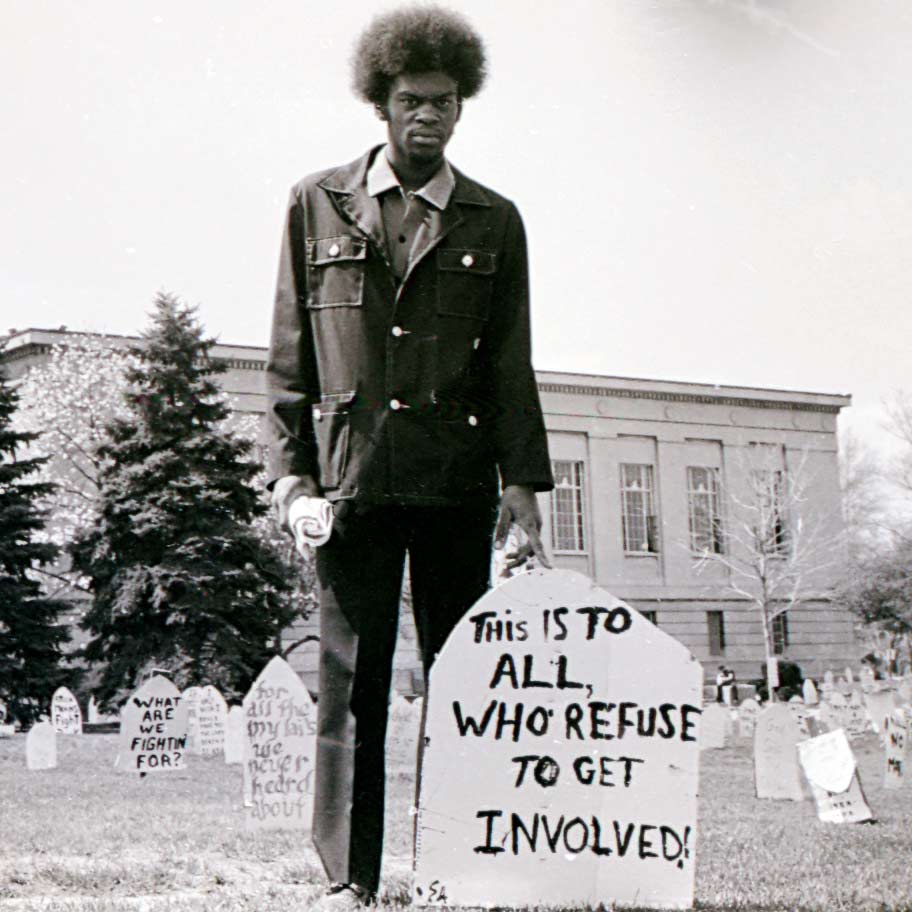Set against the backdrop of five decades of dynamic social change, the powerful ŌĆ£BUS at 50 ReloadedŌĆØ photography exhibit in Ritchie HallŌĆÖs Uumbaji Gallery highlights the impact and influence of the Black United Students (BUS) organization at ┬ķČ╣┤½├Į since its founding in 1968. The show runs through Nov. 14.
Curated by professors LaeŌĆÖl Hughes-Watkins and Idris Kabir Syed, the exhibit chronicles black student life over the last 50 years with a collection of photographs by E. Timothy Moore and Lafayette Tolliver, both students at the time the images were taken.
Mr. Moore, ŌĆÖ73, ŌĆÖ77 and ŌĆÖ83, a graphic design major, is a Kent State associate professor emeritus and also was associate dean for advising and undergraduate student affairs in the College of Arts and Sciences. Mr. Tolliver, ŌĆÖ71, one of only two black students in his journalism and mass communication program at the time, is a lawyer practicing in Toledo.
The exhibit initially opened in February for Black History Month and added additional photos for the ŌĆ£ReloadedŌĆØ version that opened on Homecoming Weekend.
ŌĆ£These images are very powerful and show the breadth of black student life over the years,ŌĆØ Mr. Syed says. ŌĆ£The photographs show everything from activism to life on campus.ŌĆØ
Indeed, the most powerful images in the exhibit document turbulent moments in Kent StateŌĆÖs history, such as a 1968 student walkout that protested police brutality and a more recent image of students laying on the ground in a mock ŌĆ£die-inŌĆØ in support of the Black Lives Matter movement. Other images show cultural events and important speakers on campus, such as iconic civil rights activists Jesse Jackson and Stokely Carmichael.
about black united students
 BUS became a registered student organization in 1968, shortly after the assassination of Dr. Martin Luther King Jr. Since that pivotal time in history, BUS has not only supported its members, but it also has led an academic sea change at Kent State by helping to establish the Institute for African American Affairs in 1969, the Center of Pan African Culture in 1970 and the Department of Pan-African Studies in 1976.
BUS became a registered student organization in 1968, shortly after the assassination of Dr. Martin Luther King Jr. Since that pivotal time in history, BUS has not only supported its members, but it also has led an academic sea change at Kent State by helping to establish the Institute for African American Affairs in 1969, the Center of Pan African Culture in 1970 and the Department of Pan-African Studies in 1976.
Mr. Syed, a Kent State alumnus, was a BUS member during his student days in the 1990s. He says the organization, now more than ever, is an important component in the black student experience on campus through both its activism and its support. A case in point was a recent daylong event organized by BUS that gave students a safe space inside Ritchie Hall during a controversial rally on the Kent Campus called by open-carry gun activists.
"It was a way to de-escalate the situation,ŌĆØ Mr. Syed says of the Ritchie Hall event. ŌĆ£BUS made a conscious choice to stay in the building that day. We as faculty also warned students against being out there ŌĆō we wanted to keep them safe.ŌĆØ
Mr. Syed says BUS will continue to play an important role in the lives of students in the coming decades.
ŌĆ£Over the next 50 years, things will continue to change, and black students will be engaging in an increasingly diverse world,ŌĆØ Mr. Syed says. ŌĆ£My hope is that students will continue to take the lessons and the skills they learn here and use them to engage with the world in positive ways.ŌĆØ
The Uumbaji Gallery is located in Room 134 on the ground floor of . The gallery hours are Monday through Friday from 9 a.m. to 5 p.m.




